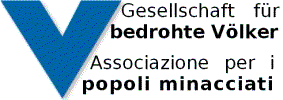

In: Home > DOSSIER > Minority Languages in India: An appraisal of the linguistic rights of minorities in India
Languages: ENG
By Thomas Benedikter
Bolzano/Bozen, March 2013
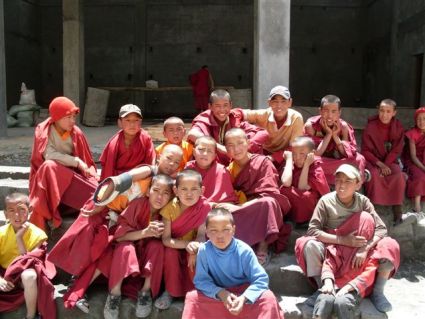 Bhotia speaking Monks at the
monastery of Dhankar, Spiti Valley, Himachal Pradesh. Foto:
Thomas Benedikter.
Bhotia speaking Monks at the
monastery of Dhankar, Spiti Valley, Himachal Pradesh. Foto:
Thomas Benedikter.
India not only is concerned with inevitable multilingualism, but also with the rights of many millions of speakers of lesser used minority languages. As the political and cultural context privileges some major languages, linguistic minorities often feel discriminated against by the current language policy of the Union and the States. The general political and cultural context of India's society at large favours the major languages as Hindi, Bengali, Marathi, Tamil, Telugu, Gujarati etc., which are generally and officially recognized in several States as state languages, but countless speakers of smaller, non recognized languages feel discriminated against by the linguistic policy as efficient regulations for their protection are very rare. The UNESCO-World Atlas of Languages in Danger for India lists 172 languages in danger, out of which 101 are classified as severely, critically or definitely endangered and 71 "vulnerable" (A complete list of India's endangered languages is provided by the "Atlas of the World's Languages in Danger" (Christopher Moseley, ed., UNESCO, Paris 2010).
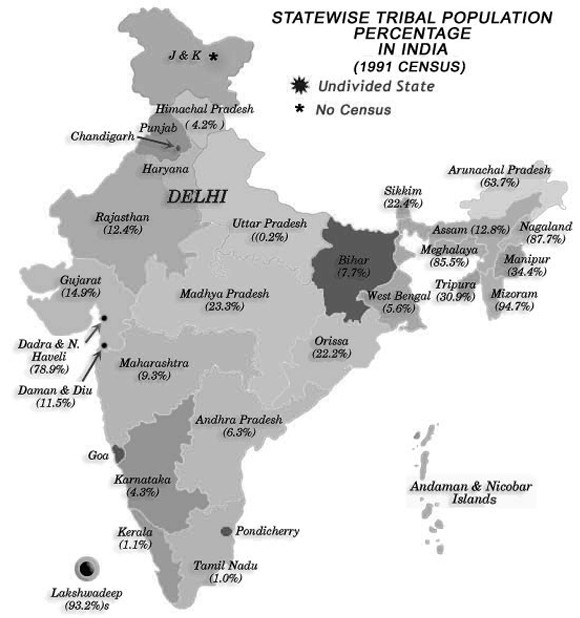 Statewise tribal population
percentage in India (1991 census).
Statewise tribal population
percentage in India (1991 census).
Yet, on the background of India's huge social and economic challenge the very issue of languages is mostly considered a side-problem, overshadowed by "communal" issues, which means religious and caste problems. Millions of speakers of minority languages experience on a daily basis that their mother tongues are deemed worthless dialects which have little utility in modern life. On the background of India's rapid cultural modernization the minority languages are continuously losing respect and linguistic domains. Since independence various languages, especially such of Adivasi peoples, have definitely disappeared, some more are on the eve of extinction. 20 years ago the situation of the non scheduled languages has been this one.
But which are the real minority languages of India, who can be termed as indigenous "linguistic minorities"? 97 percent of India's 1,2 billion citizens (2011) speak one of the 22 so called scheduled languages, which means languages officially recognized by the Constitution. On the other hand, About 3 percent speak one of the 92 smaller languages as their mother tongue or first language, which are registered as distinct languages, but not recognized under the Constitution (8th Schedule). Finally, languages spoken as a mother tongue by less than 10.000 people are not even registered in the official census. Only two of the languages of Adivasi peoples are recognized by the Constitution, Bodo and Santali.
However, even the official recognition is no guarantee for efficient measures of protection and promotion by the respective State or by federal institutions, nor does it provide an automatic recognition of such a language as an official language of all public authorities as least in the district or home area of the concerned ethno-linguistic communities. Such communities aren't necessarily small or even negligible. In India some of the non recognized languages count 5, 6 or 9 million speakers, which means more of some medium size European languages. However, the majority of such smaller languages are spoken by one of the 80 Adivasi indigenous peoples.
India's languages by scheduling (recognition under the 8th Schedule of the Constitution)
|
114 languages (registered by census) |
||
| 22 scheduled languages (97% of all speakers in 2003) 1.173 million speakers in 2011 | 92 non-scheduled languages (3% of speakers in 2003) 36,3 million speakers in 2011 | |
| scheduled languages, official in at least one state: 14 | scheduled languages, official in no state: 8 | Non scheduled languages, but registered as "languages" in national census (very few co-official on district or local level) |
| 957 mil. speakers (2001)* | 39 mil. speakers (2001)* | 24 million speakers (1991)** 31 million speakers (2001) 36 million speakers (2011) |
| Out of the 114 languages 88 are classified as "tribal languages" (including Santali and Bodo, the only scheduled tribal languages). | ||
* Urdu (51,5 million speakers in 2001) here is
counted under "official language in at least one state", as it is
the official language of Jammu and Kashmir. In reality the mother
tongues of 80% of the population of that state are Dogri and
Kashmiri. 50 million Indian citizens using Urdu as mother tongue
are living in all other States as a minority, where Urdu only in
a few cases is co-official.
** No figures for the total speakers of non-scheduled languages
of the census 2011 are available yet. By estimate they should be
36 million, as in 2011 India's population reached 1,210 million.
General figures of the census 2011 are available at: www.censusindia.gov.in and
www.census2011.co.in
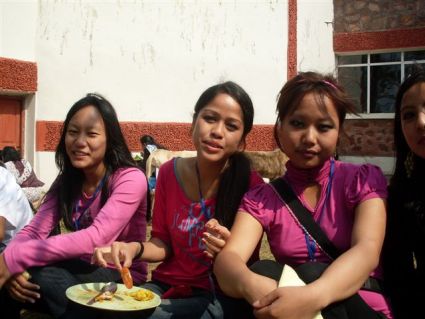 Naga students at the University off
Shillong, Meghalaya. They speak various Naga-languages as first
language. Foto: Thomas Benedikter.
Naga students at the University off
Shillong, Meghalaya. They speak various Naga-languages as first
language. Foto: Thomas Benedikter.
Is there a "national language" in India? In 2004 42 percent of India's population are reported to speak Hindi as their first language in combination with one of the many versions or dialects of Hindi. This accounts for about 500 million Indians. As many millions of non native Hindi-speakers learn this language as second or third language, thus for sure at least half of India's total population can communicate in Hindi. Nevertheless as a national medium of communication English is still more influential, given its key function for the whole higher education system, in politics, in economic life and higher management level, in research and technology, in international relations etc. Due to its colonial history the English language in India has acquired a much more dominant role as in Europe, although, according to official EU-statistics half of the EU's population affirm to be able to communicate in English. In this historic period the unstoppable advance of English in all fields of life mirrors the enforced internal integration and opening up of the country towards global markets, a development which might further deteriorate the position of minority languages.
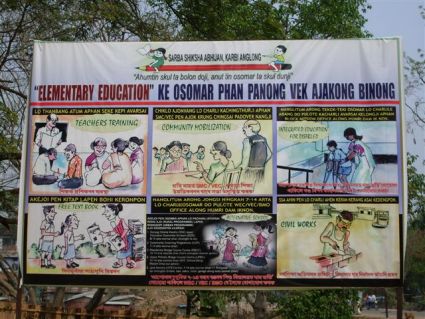 A bilingual information board in the
autonomous district of Karbi-Anlong (State of Assam). Foto:
Thomas Benedikter.
A bilingual information board in the
autonomous district of Karbi-Anlong (State of Assam). Foto:
Thomas Benedikter.
In the general context of India's multifaceted linguistic landscape the very term "linguistic minority" has to be defined very carefully. On the federal level, in India there are no coherent principles and criteria to recognize languages, therefore also coherent regulations of the adoption of State official or co-official languages are missing. Thus the definition of the official political status of a language and by consequence the rights and duties of their speakers in India's 28 States depends on the States, which detain the main responsibility for the regulation of language rights.
In the 1950ies and 1960ies India's federal structure has been re-drawn mainly along linguistic lines. But in contrast with Europe, India's vertical division of powers between hierarchical government levels does not provide for regions (in a size comparable with Italian regions, German Bundesländer os Spanish Comunidades Autonomos) endowed with basic powers of linguistic rights. Such sub-state entities, as in Europe especially when vested with autonomy status, would fit better to create the legal framework for the recognition, protection and further regulation of "regional languages", indigenous languages of "minority languages" at large. Thus, not only the 92 (out of 114) languages are not recognized by the Indian Constitution, but even bigger, official State languages are not protected by particular linguistic rights in most of the neighbouring States, where a substantial part of citizens are speaking such a language as a relative minority language of that State: e.g. Konkani is recognized in Goa, but is not protected in the bordering states of Goa (Maharashtra, Kerala). Finally, the languages Maithili, Santali, Kashmiri, Sindi, Dogri and Bodo are all recognized under the8th schedule of the Federal Constitution, but aren't official language in not a single State.
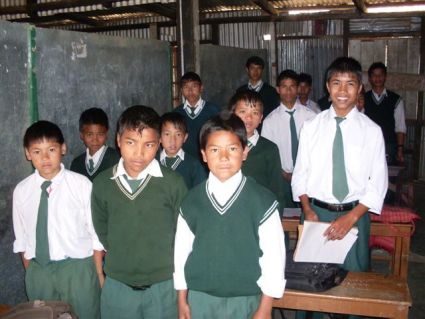 Khasi children in a school at
Nartiang, Meghalaya. Mother tongue: Khasi and Jaintia. Foto:
Thomas Benedikter.
Khasi children in a school at
Nartiang, Meghalaya. Mother tongue: Khasi and Jaintia. Foto:
Thomas Benedikter.
About 36,3 million of India's 1,2 billion strong population (census 2011) speak an "absolute minority language", a language which in every of India's 28 States forms a minority. Most of those language are Adivasi languages. Why just 36 million do speak such languages, although at least 70-80 million citizens are reported to belong to Adivasi communities? This figure reflects a long lasting and widespread discrimination of the indigenous peoples: more than half of Adivasi peoples or families still do feel as such or indicate such an identity, but they do not use anymore their original Adivasi-language. Thus the Adivasi can be considered the main victims of India's slow, but steady language erosion. In every sector of public life in India, from the education system to public administration, from the media to modern economic life, the indigenous people are suffering a high pressure of assimilation.
On the other hand it has to be acknowledged that the multilingual India is displaying much more efforts than the EU to tackle its internal linguistic variety. In Europe the medium term standard, set by the EU policy-makers, is the ability to communicate in three EU-languages, although still today the majority of the European population is still monolingual, in the sense that most of the people speak just a dialect and the national standard language. In India basically this situation is the same, but the amount of bilingual and trilingual citizens is increasing very fast. This circumstance is explicitly registered within the National Census. The main reason is also the official task of the all-India education system, the so called "three language-formula". Every child should, beyond its mother tongue, be enabled to learn two further national languages, in practice mostly Hindi an English. Now, if a child in the quite complex linguistic landscape of India, speaks an absolute and not protected minority language and wishes to be integrated and enjoy equal rights in public life, in education and information, it has to learn not only two, but three further languages, namely the respective State's language, Hindi and English. This means that such people have to master not only 3, but 4 languages. Considering that still about a third of India's population is not literate and a quarter is suffers from undernutrition, this circumstance is huge cultural challenge. Such issues are further explained in the author's analysis "Minority Languages in India", which is available here.
Thomas Benedikter
See also in gfbv.it:
www.gfbv.it/3dossier/eu-min/autonomy-w.html
| www.gfbv.it/3dossier/eu-min/work-autonomy.html
| www.gfbv.it/3dossier/eu-min/autonomy.html
| www.gfbv.it/3dossier/eu-min/autonomy-eu.html
in www: www.minorities.in